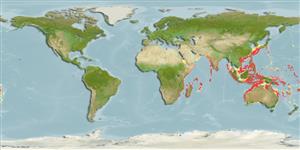Environment: milieu / climate zone / depth range / distribution range
Ekologi
marina bottenlevande; djupintervall 50 - 458 m (Ref. 58018). Tropical
Indo-West Pacific: East Africa, Maldive Islands, Japan, East China Sea, Philippines, Indonesia, New Caledonia, and Australia.
Size / Vikt / Age
Maturity: Lm ? range ? - ? cm
Max length : 8.5 cm SL hane/ej könsbestämd; (Ref. 6660)
Short description
Bestämningsnycklar | Morfologi | Morfometri
Taggstrålar i ryggfenan (totalt) : 6; Mjukstrålar i ryggfenan (totalt) : 15 - 16; Taggstrålar i analfenan: 0; Mjukstrålar i analfenan: 12 - 13. Reddish but paler below; 3 yellowish lines and 2 reddish-yellow lines on body (Ref. 6660).
Life cycle and mating behavior
Maturities | Reproduktion | Spawnings | Egg(s) | Fecundities | Larver
Matsuura, K., 2015. Taxonomy and systematics of tetraodontiform fishes: a review focusing primarily on progress in the period from 1980 to 2014. Ichthyol. Res. 62(1):72-113. (Ref. 97685)
IUCN Red List Status (Ref. 130435)
Threat to humans
Harmless
Human uses
Verktyg
Special reports
Download XML
Internet-källor
Estimates based on models
Preferred temperature (Ref.
123201): 13.5 - 25.2, mean 19.2 °C (based on 426 cells).
Phylogenetic diversity index (Ref.
82804): PD
50 = 0.5625 [Uniqueness, from 0.5 = low to 2.0 = high].
Bayesian length-weight: a=0.01995 (0.00906 - 0.04395), b=3.01 (2.83 - 3.19), in cm total length, based on all LWR estimates for this body shape (Ref.
93245).
Trofisk nivå (Ref.
69278): 4.1 ±0.7 se; based on size and trophs of closest relatives
Fishing Vulnerability (Ref.
59153): Low vulnerability (10 of 100).
